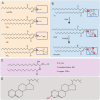Host Lipids in Positive-Strand RNA Virus Genome Replication
- PMID: 30863375
- PMCID: PMC6399474
- DOI: 10.3389/fmicb.2019.00286
Host Lipids in Positive-Strand RNA Virus Genome Replication
Abstract
Membrane association is a hallmark of the genome replication of positive-strand RNA viruses [(+)RNA viruses]. All well-studied (+)RNA viruses remodel host membranes and lipid metabolism through orchestrated virus-host interactions to create a suitable microenvironment to survive and thrive in host cells. Recent research has shown that host lipids, as major components of cellular membranes, play key roles in the replication of multiple (+)RNA viruses. This review focuses on how (+)RNA viruses manipulate host lipid synthesis and metabolism to facilitate their genomic RNA replication, and how interference with the cellular lipid metabolism affects viral replication.
Keywords: lipid metabolism; membrane association; phospholipids; positive-strand RNA virus; viral RNA replication.
Figures





Similar articles
-
Viral rewiring of cellular lipid metabolism to create membranous replication compartments.Curr Opin Cell Biol. 2017 Aug;47:24-33. doi: 10.1016/j.ceb.2017.02.005. Epub 2017 Feb 24. Curr Opin Cell Biol. 2017. PMID: 28242560 Free PMC article. Review.
-
Complementary transcriptomic, lipidomic, and targeted functional genetic analyses in cultured Drosophila cells highlight the role of glycerophospholipid metabolism in Flock House virus RNA replication.BMC Genomics. 2010 Mar 17;11:183. doi: 10.1186/1471-2164-11-183. BMC Genomics. 2010. PMID: 20236518 Free PMC article.
-
Cell-Free and Cell-Based Approaches to Explore the Roles of Host Membranes and Lipids in the Formation of Viral Replication Compartment Induced by Tombusviruses.Viruses. 2016 Mar 3;8(3):68. doi: 10.3390/v8030068. Viruses. 2016. PMID: 26950140 Free PMC article. Review.
-
Reconstitution of an RNA Virus Replicase in Artificial Giant Unilamellar Vesicles Supports Full Replication and Provides Protection for the Double-Stranded RNA Replication Intermediate.J Virol. 2020 Aug 31;94(18):e00267-20. doi: 10.1128/JVI.00267-20. Print 2020 Aug 31. J Virol. 2020. PMID: 32641477 Free PMC article.
-
Role of host reticulon proteins in rearranging membranes for positive-strand RNA virus replication.Curr Opin Microbiol. 2012 Aug;15(4):519-24. doi: 10.1016/j.mib.2012.04.007. Epub 2012 May 21. Curr Opin Microbiol. 2012. PMID: 22621853 Free PMC article. Review.
Cited by
-
An overview of the role of Niemann-pick C1 (NPC1) in viral infections and inhibition of viral infections through NPC1 inhibitor.Cell Commun Signal. 2023 Dec 14;21(1):352. doi: 10.1186/s12964-023-01376-x. Cell Commun Signal. 2023. PMID: 38098077 Free PMC article. Review.
-
The roles of lipids in SARS-CoV-2 viral replication and the host immune response.J Lipid Res. 2021;62:100129. doi: 10.1016/j.jlr.2021.100129. Epub 2021 Sep 29. J Lipid Res. 2021. PMID: 34599996 Free PMC article. Review.
-
RNA-dependent RNA polymerase of predominant human norovirus forms liquid-liquid phase condensates as viral replication factories.bioRxiv [Preprint]. 2024 Sep 18:2023.08.24.554692. doi: 10.1101/2023.08.24.554692. bioRxiv. 2024. Update in: Sci Adv. 2024 Dec 20;10(51):eadp9333. doi: 10.1126/sciadv.adp9333. PMID: 39345611 Free PMC article. Updated. Preprint.
-
Subversion of phosphorylated SR proteins by enterovirus A71 in IRES-dependent translation revealed by RNA-interactome analysis.PLoS Pathog. 2025 Jun 16;21(6):e1013242. doi: 10.1371/journal.ppat.1013242. eCollection 2025 Jun. PLoS Pathog. 2025. PMID: 40522993 Free PMC article.
-
Dynamic interplay between the co-opted Fis1 mitochondrial fission protein and membrane contact site proteins in supporting tombusvirus replication.PLoS Pathog. 2021 Mar 16;17(3):e1009423. doi: 10.1371/journal.ppat.1009423. eCollection 2021 Mar. PLoS Pathog. 2021. PMID: 33725015 Free PMC article.
References
-
- Adachi-Yamada T., Gotoh T., Sugimura I., Tateno M., Nishida Y., Onuki T., et al. . (1999). De novo synthesis of sphingolipids is required for cell survival by down-regulating c-Jun N-terminal kinase in Drosophila imaginal discs. Mol. Cell. Biol. 19, 7276–7286. 10.1128/MCB.19.10.7276 - DOI - PMC - PubMed
-
- Albert B., Johnson A., Lewis J., Raff M., Roberts K., Walter P. (2002). The Lipid Bilayer in Molecular Biology of the Cell. New York, NY: Garland Science.
Publication types
Grants and funding
LinkOut - more resources
Full Text Sources

